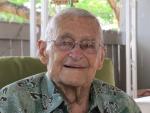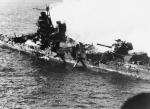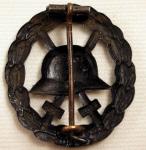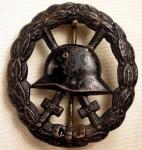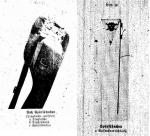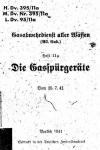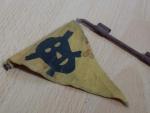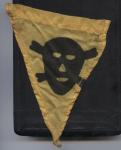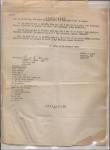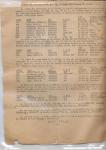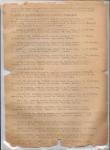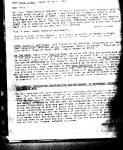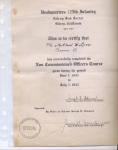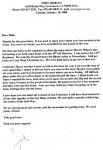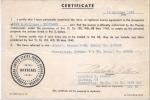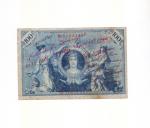-
Posts
8,000 -
Joined
-
Last visited
-
Days Won
3
Content Type
Profiles
Forums
Blogs
Gallery
Events
Store
Everything posted by Hauptmann
-

Mixed Unknown German stuff....
Hauptmann replied to Chris Boonzaier's topic in Germany: Post 1945: Bundesrepublik & DDR
The one on the upper left seems to be Bavarian. The one on the upper right is probably either Soviet, Bulgarian or other Warsaw Pact for Motor Transport Troops. Here's a shot of a set in a riker with shoulder patch. The one you have is for the collar tabs. http://www.angelfire.com/tx2/russianbear/displaysovietmotortran.html Dan :cheers: -

Many Think This Is A Disgrace
Hauptmann replied to ladybird's topic in Great Britain: Research, Documentation & History
This is a shame, but after reading it through they said they are limited in the number of people who can attend... there can be a number of reasons for this. They said they've tried to limit it to surviving crew members and families of those crew members who gave their lives in service. But you would think that someone as involved in trying to get funding for this would have been invited straight off. In a perfect world... which sadly this is not. I pray he'll get to go to at least one if not several of the other events that are planned. A very brave man! Dan :cheers: -
http://news.yahoo.com/navy-marks-battle-midways-70th-anniversary-073947792.html Navy marks Battle of Midway's 70th anniversary By AUDREY McAVOY | Associated Press – Tue, Jun 5, 2012 In this photo taken May 31, 2012, retired Rear Adm. Mac Showers, the last surviving member of the intelligence team that deciphered Japanese messages in the lead up to the Battle of Midway, is seen in Pearl Harbor, Hawaii. Showers and Navy officials are observing the 70th anniversary of the battle that changed the course of World War II on Monday, June 4, 2012. (AP Photo/Audrey McAvoy) FILE - In this June 1942 file photo, a Mogami class Japanese cruiser is the flaming target of carrier-based U.S. naval aircraft in the historic battle of Midway which raged for three days in June 1942. On Monday, June 4, 2012, the Navy marks the 70th anniversary of a battle that turned the tide of World War II. (AP Photo, file) PEARL HARBOR, Hawaii (AP) — Six months after the devastating attack on Pearl Harbor, Japan sent four aircraft carriers to the tiny Pacific atoll of Midway to draw out and destroy what remained of the U.S. Pacific Fleet. But this time the U.S. knew about Japan's plans. U.S. cryptologists had cracked Japanese communications codes, giving Fleet Commander Adm. Chester Nimitz notice of where Japan would strike, the day and time of the attack, and what ships the enemy would bring to the fight. The U.S. was badly outnumbered and its pilots less experienced than Japan's. Even so, it sank four Japanese aircraft carriers the first day of the three-day battle and put Japan on the defensive, greatly diminishing its ability to project air power as it had in the attack on Hawaii. On Monday, current Pacific Fleet commander, Adm. Cecil Haney and other officials flew 1,300 miles northwest from Oahu to Midway to mark the 70th anniversary of the pivotal battle that changed the course of the Pacific war. Midway is now a National Wildlife Refuge hosting more than one million seabirds. Navy photos of the ceremony show an honor guard standing at attention next to a field of ground-nesting Laysan albatross and other seabirds. "After the battle of Midway we always maintained the initiative and for the remaining three years of the war, the Japanese reacted to us," Vice Adm. Michael Rogers, commander of the U.S. Fleet Cyber Command, told a crowd gathered outside Nimitz's old office at Pearl Harbor on Friday to commemorate the role naval intelligence played in the events of June 4-7, 1942. "It all started really in May of 1942 with station Hypo (the Combat Intelligence Unit at Pearl Harbor) and the work of some great people working together to try to understand what were the Japanese thinking, what were they going to do," Rogers said Friday. Intelligence wasn't the only reason for U.S. victory. The brave heroics by dive bomber pilots, Japanese mistakes and luck all played a role. But Nimitz himself observed that the code-breaking was critical to the outcome, said retired Rear Adm. Mac Showers, the last surviving member of the intelligence team that deciphered Japanese messages. "His statement a few days later was 'had it not been for the excellent intelligence that was provided, we would have read about the capture of Midway in the morning newspaper,'" said Showers said in an interview. Japan's vessels outnumbered U.S. ships 4-to-1, Japan's aviators had more experience, and its Zero fighter planes could easily outmaneuver U.S. aircraft. But Japan, unlike the U.S., had little knowledge of what its enemy was doing. Japanese commanders believed a U.S. task force was far away in the Solomon Islands. Then, as June 4 neared and Nimitz prepared his troops, Japanese commanders failed to recognize signs of increased military activity around Hawaii as an indication the U.S. had uncovered their plans to attack Midway, the site of a small U.S. base. The U.S. lost one carrier, 145 planes and 307 men. Japan lost four aircraft carriers, a heavy cruiser, 291 planes and 4,800 men, according to the U.S. Navy and to an account by former Japanese naval officers in "Midway: The Battle That Doomed Japan, the Japanese Navy's Story." The defeat was so overwhelming that the Japanese navy kept the details a closely guarded secret and most Japanese never heard of the battle until after the war. Nimitz got his intelligence from Showers and a few dozen others relentlessly analyzing Japanese code in the basement of a Pearl Harbor administrative building. Japanese messages were written using 45,000 five-digit numbers representing phrases and words. The cryptographers had to figure out what the numbers said without the aid of computers. "In order to read the messages, we had to recover the meaning of each one of those code groups. The main story of our work was recovering code group meanings one-by-painful-one," Showers said. At the time of the Dec. 7, 1941, attack on Pearl Harbor, they understood a small fraction of the messages. By May 1942, they could make educated guesses. A key breakthrough came when they determined Japan was using the letters "AF" to refer to Midway. Showers said Cmdr. Joseph Rochefort, the team's leader, and Nimitz were confident the letters referred to the atoll. But Adm. Ernest King, the Navy's top commander, wanted to be sure before he allowed Nimitz to send the precious few U.S. aircraft carriers out to battle. So Nimitz had the patrol base at Midway send a message to Oahu saying the island's distillation plant was down, and it urgently needed fresh water. Soon after, both an intelligence team in Australia and Rochefort's unit picked up a Japanese message saying "AF" had a water shortage. Showers was an ensign in the office, having just joined the Navy. He analyzed code deciphered by cryptographers, plotted ships on maps of the Pacific, and filed information. Now 92 and living in Arlington, Va., the Iowa City, Iowa, native went on to a career in intelligence. He served on Nimitz's staff on Guam toward the end of the war, and returned later to Pearl Harbor for stints leading the Pacific Fleet's intelligence effort. After the Navy, he worked for the Central Intelligence Agency. Showers said commanders weren't always as open to using intelligence to plan their course of attack the way Nimitz was. Some were suspicious of it. But Midway changed that. "It used to be a lot of people thought intelligence was something mysterious and they didn't believe in it and they didn't have to pay attention to it. Admiral Nimitz was fortunately what we call intelligence-friendly," Showers said.
-
http://news.yahoo.com/us-navy-hopes-stealth-ship-answers-rising-china-065329046.html US Navy hopes stealth ship answers a rising China FILE - This file image released by Bath Iron Works shows a rendering of the DDG-1000 Zumwalt, the U.S. Navy's next-generation destroyer, which has been funded to be built at Bath Iron Works in Maine and at Northrop Grumman's shipyard in Pascagoula, Miss. The super-stealthy warship that could underpin the U.S. navy's China strategy will be able to sneak up on coastlines virtually undetected and pound targets with electromagnetic "railguns" right out of a sci-fi movie. (AP Photo/Bath Iron Works, File) By ERIC TALMADGE | Associated Press – Mon, Jun 4, 2012 SINGAPORE (AP) — A super-stealthy warship that could underpin the U.S. navy's China strategy will be able to sneak up on coastlines virtually undetected and pound targets with electromagnetic "railguns" right out of a sci-fi movie. But at more than $3 billion a pop, critics say the new DDG-1000 destroyer sucks away funds that could be better used to bolster a thinly stretched conventional fleet. One outspoken admiral in China has scoffed that all it would take to sink the high-tech American ship is an armada of explosive-laden fishing boats. With the first of the new ships set to be delivered in 2014, the stealth destroyer is being heavily promoted by the Pentagon as the most advanced destroyer in history — a silver bullet of stealth. It has been called a perfect fit for what Washington now considers the most strategically important region in the world — Asia and the Pacific. Though it could come in handy elsewhere, like in the Gulf region, its ability to carry out missions both on the high seas and in shallows closer to shore is especially important in Asia because of the region's many island nations and China's long Pacific coast. "With its stealth, incredibly capable sonar system, strike capability and lower manning requirements — this is our future," Adm. Jonathan Greenert, chief of naval operations, said in April after visiting the shipyard in Maine where they are being built. On a visit to a major regional security conference in Singapore that ended Sunday, U.S. Defense Secretary Leon Panetta said the Navy will be deploying 60 percent of its fleet worldwide to the Pacific by 2020, and though he didn't cite the stealth destroyers he said new high-tech ships will be a big part of its shift. The DDG-1000 and other stealth destroyers of the Zumwalt class feature a wave-piercing hull that leaves almost no wake, electric drive propulsion and advanced sonar and missiles. They are longer and heavier than existing destroyers — but will have half the crew because of automated systems and appear to be little more than a small fishing boat on enemy radar. Down the road, the ship is to be equipped with an electromagnetic railgun, which uses a magnetic field and electric current to fire a projectile at several times the speed of sound. But cost overruns and technical delays have left many defense experts wondering if the whole endeavor was too focused on futuristic technologies for its own good. They point to the problem-ridden F-22 stealth jet fighter, which was hailed as the most advanced fighter ever built but was cut short because of prohibitive costs. Its successor, the F-35 Joint Strike Fighter, has swelled up into the most expensive procurement program in Defense Department history. "Whether the Navy can afford to buy many DDG-1000s must be balanced against the need for over 300 surface ships to fulfill the various missions that confront it," said Dean Cheng, a China expert with the Heritage Foundation, a conservative research institute in Washington. "Buying hyperexpensive ships hurts that ability, but buying ships that can't do the job, or worse can't survive in the face of the enemy, is even more irresponsible." The Navy says it's money well spent. The rise of China has been cited as the best reason for keeping the revolutionary ship afloat, although the specifics of where it will be deployed have yet to be announced. Navy officials also say the technologies developed for the ship will inevitably be used in other vessels in the decades ahead. But the destroyers' $3.1 billion price tag, which is about twice the cost of the current destroyers and balloons to $7 billion each when research and development is added in, nearly sank it in Congress. Though the Navy originally wanted 32 of them, that was cut to 24, then seven. Now, just three are in the works. "Costs spiraled — surprise, surprise — and the program basically fell in on itself," said Richard Bitzinger, a security expert at Singapore's Nanyang Technological University. "The DDG-1000 was a nice idea for a new modernistic surface combatant, but it contained too many unproven, disruptive technologies." The U.S. Defense Department is concerned that China is modernizing its navy with a near-term goal of stopping or delaying U.S. intervention in conflicts over disputed territory in the South China Sea or involving Taiwan, which China considers a renegade province. China is now working on building up a credible aircraft carrier capability and developing missiles and submarines that could deny American ships access to crucial sea lanes. The U.S. has a big advantage on the high seas, but improvements in China's navy could make it harder for U.S. ships to fight in shallower waters, called littorals. The stealth destroyers are designed to do both. In the meantime, the Navy will begin deploying smaller Littoral Combat Ships to Singapore later this year. Officially, China has been quiet on the possible addition of the destroyers to Asian waters. But Rear Adm. Zhang Zhaozhong, an outspoken commentator affiliated with China's National Defense University, scoffed at the hype surrounding the ship, saying that despite its high-tech design it could be overwhelmed by a swarm of fishing boats laden with explosives. If enough boats were mobilized some could get through to blow a hole in its hull, he said. "It would be a goner," he said recently on state broadcaster CCTV's military channel. ___ AP writer Christopher Bodeen contributed to this report from Beijing.
-

Bundesrepublik Show your West German Helmets !
Hauptmann replied to SteveL's topic in Germany: Post 1945: Bundesrepublik & DDR
Federal Border Guard (Bundesgrenzschutz) guards at the Presidential Chancellery in Bonn. Dan :cheers: -
http://money.cnn.com/video/technology/2012/05/24/t-ts-wpafb-mini-machines.cnnmoney/
-
Hi all. Another piece from a grouping that Nick's (Obergefreiter) brother in law got from a WW2 veteran who brought them all back. He sent the collection to Nick for ID, valuation and hopefully sale. Nick and I met over in Devils Lake at the coffee house again last week... I took my Epson and did scans of just about everything in the collection. I believe this one is one of the small pennants that came in a kit with metal rods and were used to mark mine fields. It was very wrinkled and we were lucky to get it flat enough with something on top of it in order to get a scan. Both sides are the same so we only did the one. Once carefully flattened out it will make a nice display piece. Dan :cheers:
-

Uncategorised Black and Silver Wound Badges
Hauptmann replied to Hauptmann's topic in Wehrmacht Medals, Decorations & Awards
Sorry kiddo... they're like potato chips... can't have just one! Dan :cheers: -
-
-
-
-
-
-
-
Nick finished the scans today and popped them over to me so I could resize and post since I can put them in at a larger size. So here goes... First off... a short snorter on an Imperial German 100 Mark note:
-

Uncategorised 25 Panzer Assault Badge
Hauptmann replied to Hauptmann's topic in Wehrmacht Medals, Decorations & Awards
Yup... definitely one to drool over. It's built like a brick battleship... very well made. I only wish I'd handled a ton over the years but this is my first. If it's not good then I think it's time for Nick and I both to just throw our hands up and give up the game. Dan :cheers:


